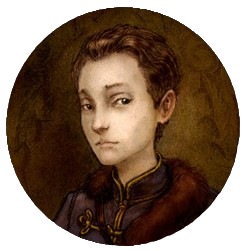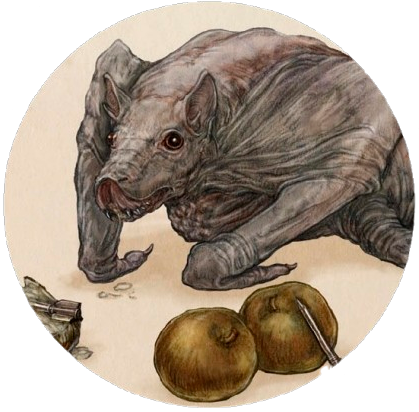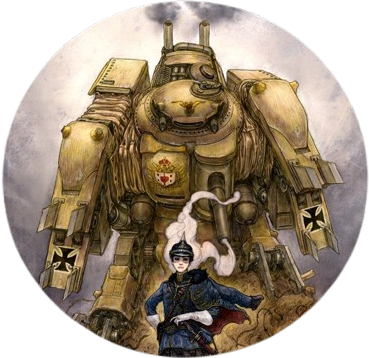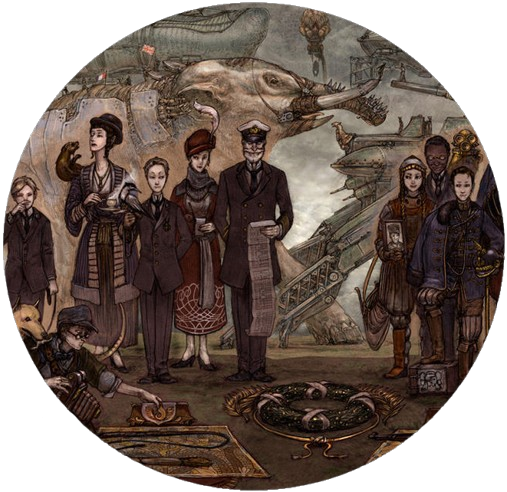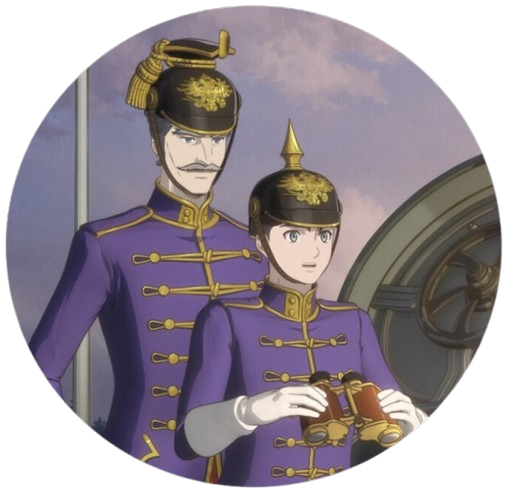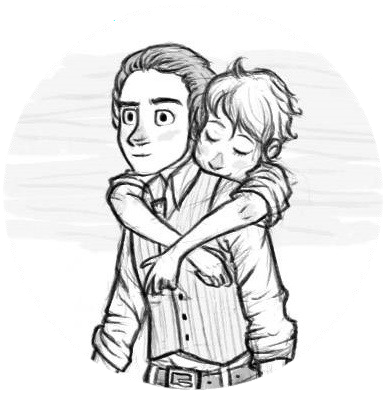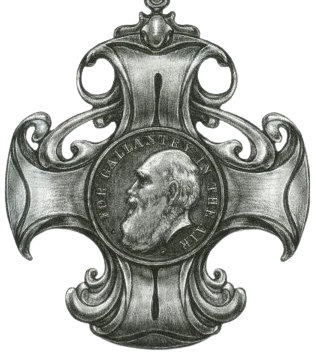
World
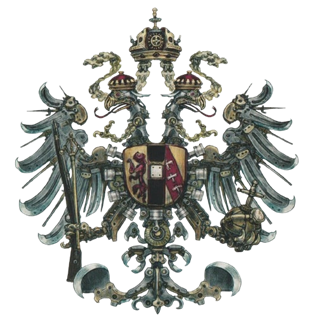
One of the things that I think makes a book really great is great worldbuilding. I mean, I love characters and plot, but I think really good worldbuilding takes a good book to a great book. Leviathan has some great worldbuilding, based both in history and created for the world of the novel. And it really is WORLD building, since the book takes place around nearly the entire world.
Darwinists
The Darwinist powers generally align to the Allied powers in our history, and though they all use fabricated animals as their main technology, cultural differences show in the different kinds of beasts they create and use. There are more Darwinist powers than those I mention on this page, but I'm focusing on the countries that feature most in the books.
Great Britain
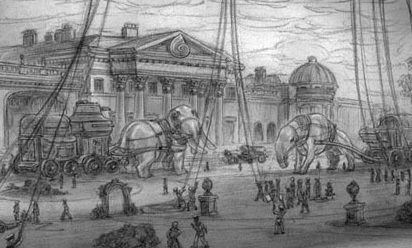
Great Britain in this world is much like how it is in our world, i.e. a huge imperial power. It is also the birthplace of Darwinist fabrications, since, as the name implies, it was invented by Charles Darwin. Most of the beasties in the books are from Great British scientists, which makes sense since a lot of the main characters and the main airship are all British. Other beasties that are common in Britain are elephantines, which are pictured above, and tigeresques, which are huge cats that do labour like pulling carts and busses.
The culture of England in these books is pretty similar to IRL England in 1914, though we don't see much of it beyond the interactions of the British characters since we don't spend a lot of time in England. One of the funnier parts of what we do know about England is the existance of a group of people called Monkey Luddites, who are people who are scared of fabricated beasts, similar to the actual luddites who were people that destroyed machinery during the industrial revolution. Deryn makes a lot of mocking remarks about them because she is basically the exact opposite.
Russia
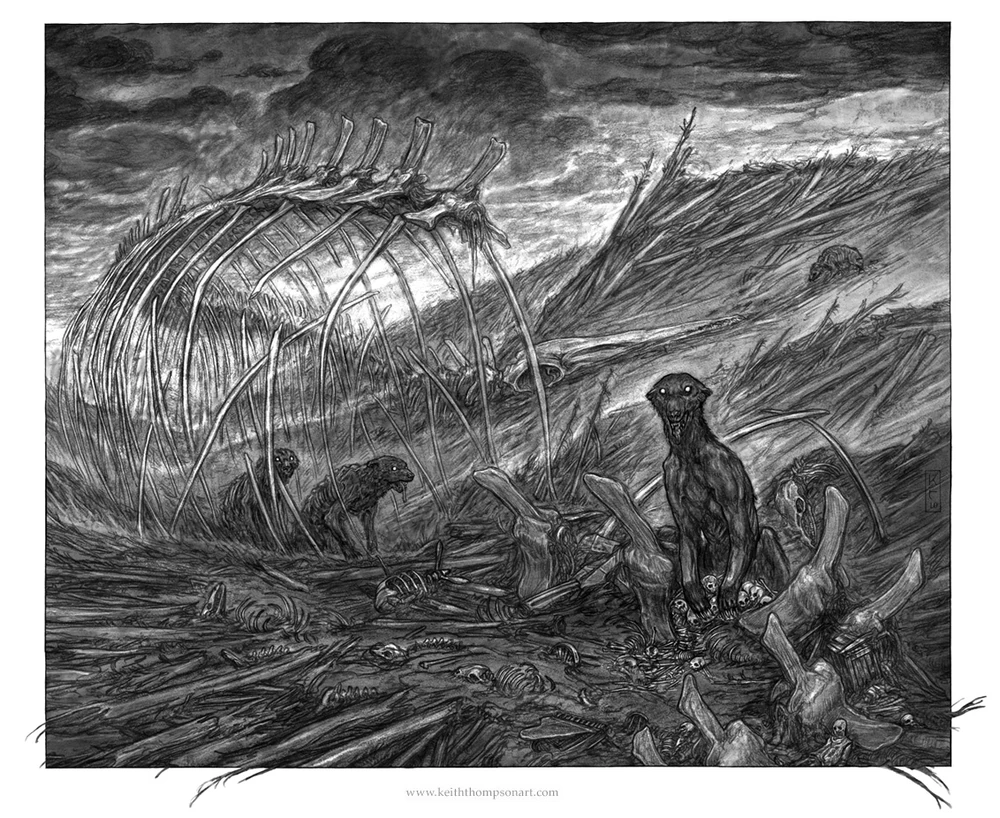
Not a lot of time is spent in Russia in the books, but as it's one of England's main allies in the war it's discussed quite a bit. The main fabricated beastie that Russia is known for are their fighting bears, huge creatures that people ride on the backs of and who can tear through walkers. Apparently the STANDARD size for a fighting bear is as big as a house, and their smallest size is around 12 feet tall. They're fitted with razors on their legs and can carry several riflemen or even mounted machine guns. The fighting bears are also difficult to handle, and are known to attack their handlers. It's no wonder then that the fighting bears are the most feared of the darwinist beasties. The main tactic that the Clankers take against the fighting bears is to cut off Russian supply trains, since the fighting bears need so much food that it won't take long to starve them out.
The place in Russia that the book spends the most time on is the real life Tunguska area in Siberia. The Tunguska event was an explosion that happened in 1908, though I believe in the books it happens closer to 1914. The explosion caused trees in a huge radius to all fall back from the center of the explosion, so that the area looked like it was layered in huge sticks all pointing to the source. In the real world this explosion is generally understood to have been the result of an asteroid hitting the atmosphere. The image above is from Tunguska, and the starving fighting bears that ate a crashed air beast not unlike the Leviathan. Crazy stuff happening in Russia.
Japan
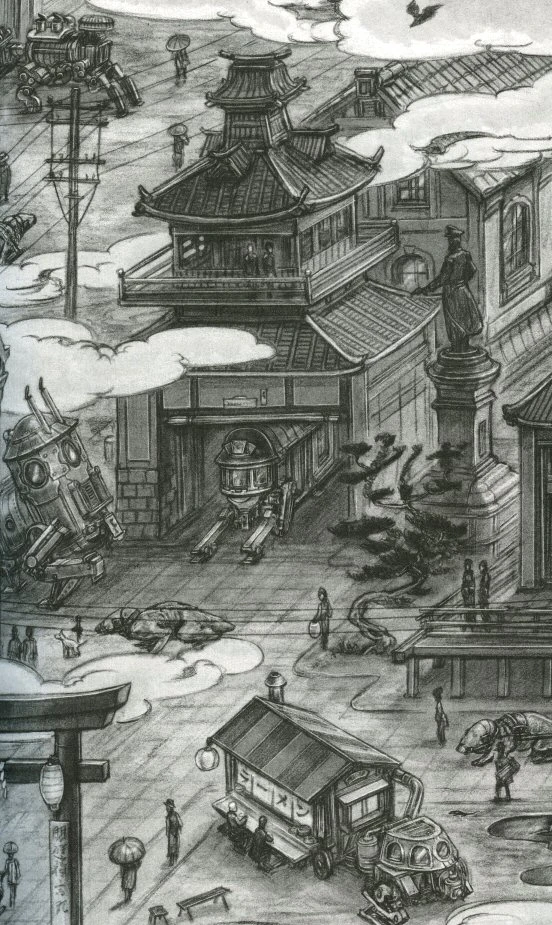
Japan is a really interesting country in Leviathan, especially because it is the first country in the books where they use both Darwinist and Clanker technology. Japan is a Darwinist power, and as such uses mainly fabricated beast technology, but they have also incorporated Clanker tools as well, something that suprises the main characters. Carts are pulled by fabricated salamander like beasties, but also by steam powered engines. They use not only messanger hawks and message lizards, but telegraph lines. It is the first place the characters visit that suggests that Darwinist and Clanker technologies need not always be enemies. It is also just a really cool location, full of beautiful and strange sights.
A lot of the warfare happening in Japan is ocean related, so the two main war beasties the Japanese use are Kraken, which are squid like beasties that are used by nearly all non-landlocked Darwinist powers, and Kappa, which are specific to Japan. Named after the creature from Japanese myth, Kappa are semi-aquatic and attack ships in hoards, killing off most of the sailors and forcing the rest to surrender. Where Kraken nearly invariably destroy the ship itself, Kappa are able to leave the ship mostly unharmed so that the Japanese navy can use it. They're very cool and creepy looking and one of my favourite examples of region and culture-specific Darwinist creations.
Clankers
The Clanker powers align with the central powers of actual history, and they use steam powered walking machines and other mechanical marvels as their main technology. A common sentiment among Clankers is that Darwinist creations go against God and therefore they're all heathens. The Clanker countries and machinery are very cool, and my favourite example of localization of technology is from a Clanker country.
Austria-Hungary
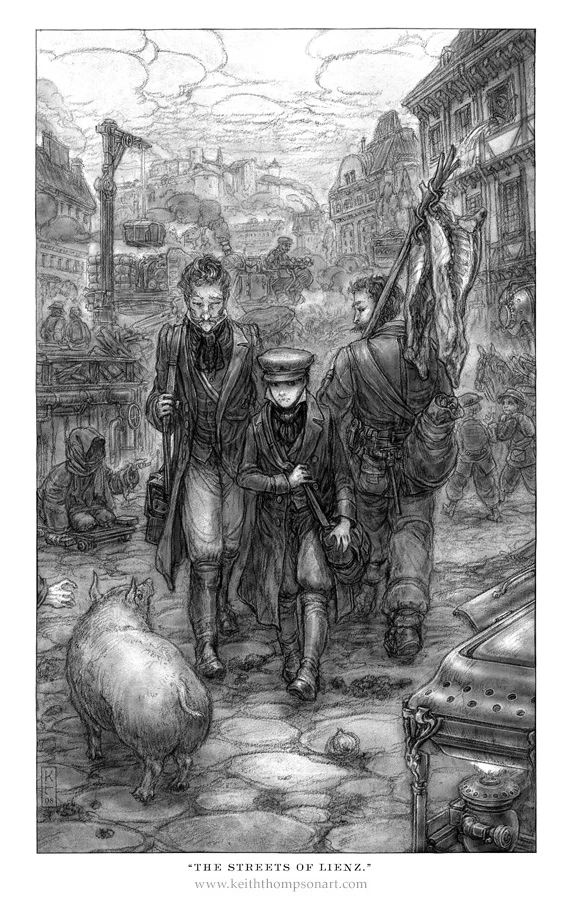
Austria-Hungary is an interesting country in these books. Most of the time spent in it is when Alek and his men are trying to escape to Switzerland, so most of what we see of it is the country side and small villages that the characters venture into for supplies. Unlike a lot of the other countries visited in the books, we don't see Austria-Hungary where she's strongest, which would likely be in the capital of Vienna. This is actually pretty culturally relavant as Austria-Hungary is not really a powerful country in the books. Instead it takes on the vibe of being Germany's toadie, doing her bidding and using her war walkers. The only walker of Austria-Hungarian origin in the books is the Cyklop Stormwalker that Alek and his men pilot. In real life Austria-Hungary was in a similar position at this time, and would be disolved and break apart into seperate states after this war. In the books it seems to be in a similarily precarious state, which is not helped by it being beset on by Russian fighting bears, who are really doing a number on her. Alek is the heir to the Austira-Hungarian throne, which is why he has to flee under threat of those who would rather he didn't come to power and be able to stop the war. However, there is always the possibility that there will be no throne for him to inherit after his stinky grandfather dies...
Germany
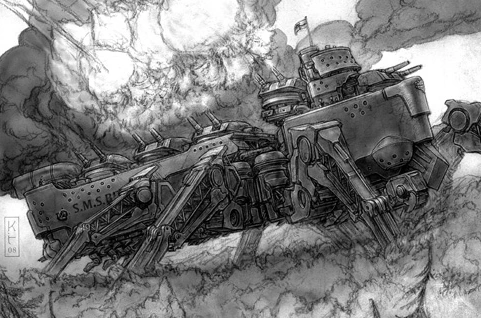
The presence of Germany is felt throughout the books, even though the characters never visit. Germany is the main power behind the war, German assassins having been behind Archduke Franz Ferdinand's death in this alternate history. They are looking for war and would do anything to keep it going, which is why Alek has to flee from them. They have very powerful Clanker technology, mainly huge 'land frigates' that are like enormous tanks on several legs. The Beowulf, pictured above, and the Herkules are two of the most prominent walkers, at least in the first book. They're enormous machines, towering over trees and tearing up the land with their footsteps. The threat of them is truly terrifying, and their strength shows how strong and intimidating Germany is.
The Ottoman Empire
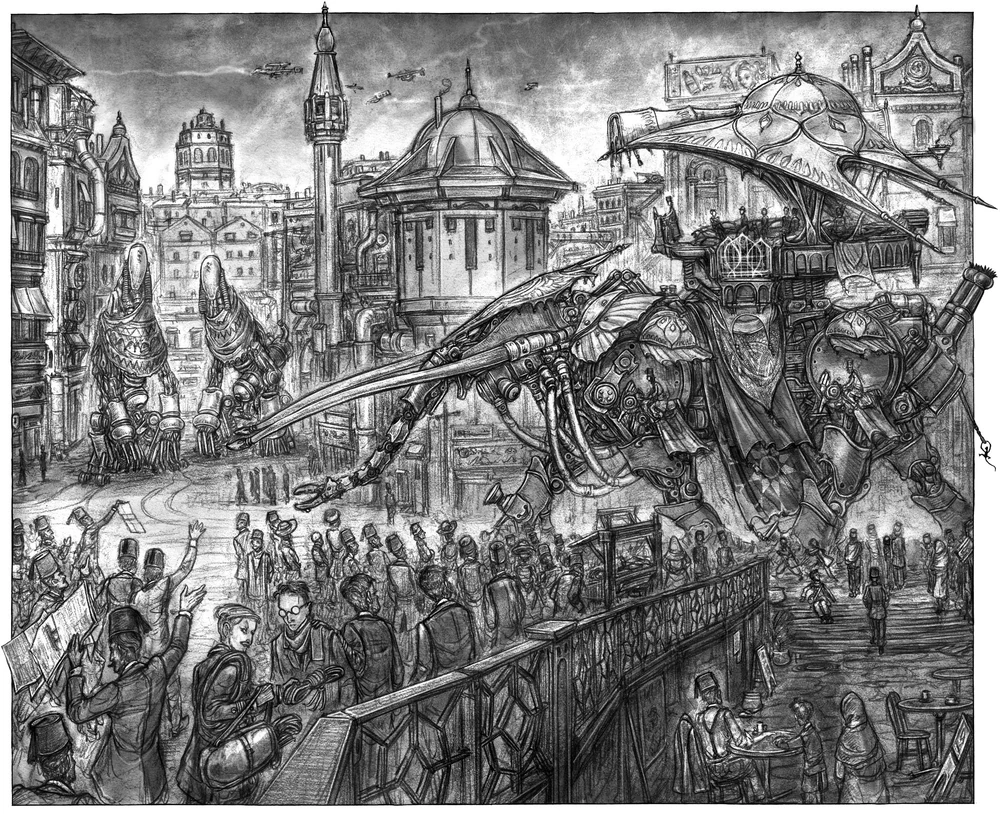
The Ottoman Empire is, I think, my favourite country location in the books. A huge chunk of the second book takes place in Istanbul, and it is a facinating and beautiful look at how Clanker technology could be used. There are several different ethnic groups in Istanbul, and they all have unique types of walkers that guard their areas of the city. The Jewish people have Iron Golems, which you can see in the background of the image above, the Greeks have Minotaurs, the Arabic people have Djinn, and the Kurdish people have Şahmaran and other walkers like her. The ways that the city is described, with the different groups of people being seperate and yet working together, is an inspiration to the young main characters about differences making communities stronger.
There are many other uses for Clanker technology in use in Istanbul as well. There's an eight-legged printing press called the Spider, scarab beetle shaped taxis, a whole library staffed by steam powered machines, and clockwork servants shaped like men. It's all a facinating look at how Clanker technology doesn't have to be threatening and industrial, which is all the characters have encountered up until this point. It can also be beautiful, creative, and full of life.
While in Istanbul the main characters encounter a revolutionist sect called the Commitee for Union and Progress, which is trying to overthrow the Sultan and make the Ottoman Empire a collaborative nation that respects all the different groups that make up her population. Despite all the different ethnic groups seeming very divided at first, with their cultural walkers guarding the entrance to their parts of the city, the Commitee has a collection of all the different kinds of walkers, showing how they are interested in bringing these different cultures and peoples together and making the Ottoman Empire a more democratic country. It's a facinating storyline and a really intricate location, and I really love all the chapters that take place in Istanbul for the atmosphere and the worldbuilding that went into it.
C-C-C-C-COMBOOOOs
There are some countries in the books that are neither Darwinist or Clanker, either by affiliation in the war or by technology. Switzerland is, of course, neutral, but we don't spend any time actually interacting with any Swiss people or see what kind of tech they tend to use. There are other countries, however, that have both Clanker and Darwinist technologies, and demonstrate a new world where the two technologies and ideologies can exist alongside each other. They're a facinating look at how this alternate history could look in the future.
Mexico
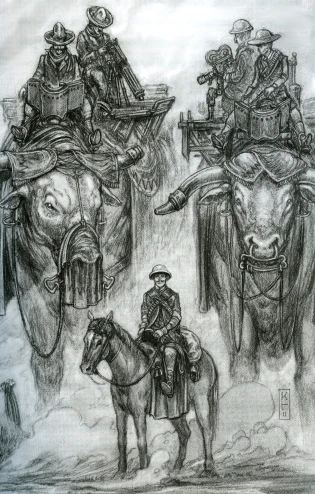
Mexico in this book is in the middle of a revolution, which is kinda wild because how do they keep stumbling into countries in revolution? And also end up hanging out with the people in charge of the revolution? I love YA books they just do whatever they want. Anyway, Mexico is similar to Japan in that they have a mix of Darwinist and Clanker technologies. Their fabs and machines are pretty unique, partly because until now we've only seen fabs and machines from Europe and Asia. Some of the fabs they have are fighting bulls, which are pictured above, and six-legged donkeys. These are mainly beasts of burden, though fighting bulls can also be used in warfare with metal tipped horns and the tendancy to charge at the enemy lines. They also have some airbeasts, including the Manta Cutter which is made out of the life threads of a manta ray and can cut through air like a ray cuts through water. The Manta Cutter is especially interesting because it uses both Darwinist and Clanker technology in one. Even in countries that use both kinds of tech they still don't often make machines that combine them into one. The Manta Cutter is really powerful for its small size as well, showing how by combining tech can make people stronger. A great metaphor imo. They also have a really cool walker called El Pollo Grande, which is a two legged walker armed with a video camera. It's made out of scrapped and repurposed parts of German war walkers, which I think is really cool because there's not a lot of examples in the books of remaking Clanker machines out of broken down ones, and I love machines made out of scavanged materials I think they're so cool. Also its name translates into "the big chicken" so like I think it's probably the best walker in the books lol
The United States
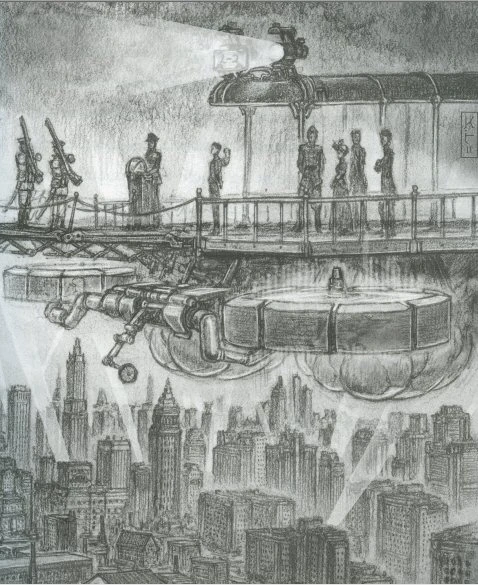
The chapters that happen in the US are all really interesting to me. Like Mexico, the US mixes Clanker and Darwinist tech pretty freely. Well, kind of freely at least. There's some north/south division between tendencies towards certain tech, but there's also a lot of tech mixing, like one character who has a Clanker camera with a Darwinist powered flash (special fireflies I think) The main part of US culture that the characters see is their film industry; at one point they get to watch a silent film and hang out with old timey movie makers. They spend some time in California and in New York, and I think the majority of the actual historical characters, or characters that are based on real life people at least, are American. It's pretty funny that we spend so little time in America and yet Scott's American bias still manages to show lol. I can't really blame the guy, if I were writing an alternate history that mainly takes place in Europe I'd include some gratuitous Canadian scenes for no reason too.
Something that's cool about America in the books is that according to one of the characters, around 5% of walker pilots in America are women, which is very interesting to Deryn of course. I don't remember if Amelia Earhart is mentioned in the books at all, but can you IMAGINE if Deryn could meet her?? I feel like I remember reading a bunch of fanfics along those lines back in the day. Anyway, while in America there is a sense among the characters of forward movement and progress, which is so great. There's not a whole lot of time spent in America, but it feels impactful on the main character's worldview, which is I think part of what I like in general about the worldbuilding in these books. All the locations seem to have a real impact on the story and the characters, and help push not only the plot but the character development forward.
.png)

